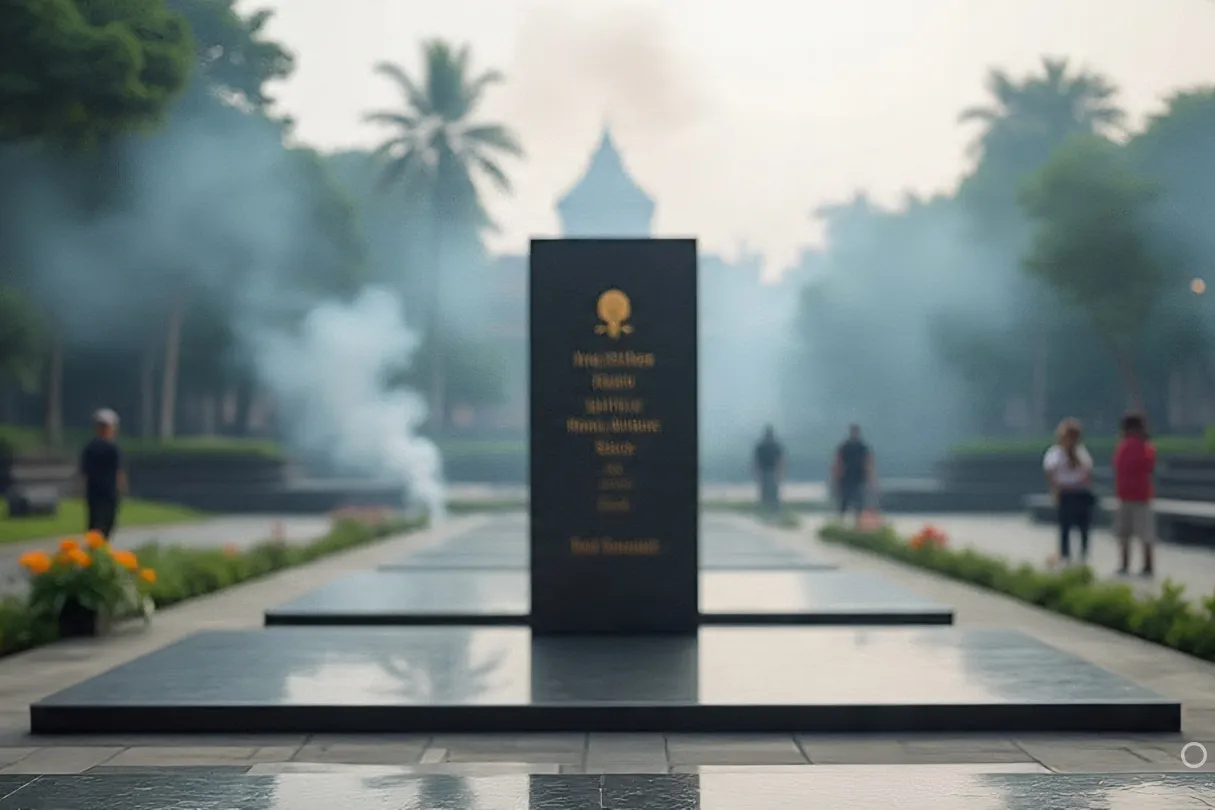On the night of October 12, 2002, paradise turned to hell.
The vibrant streets of Kuta, Bali—a place known for its surf, nightlife, and serenity—were rocked by two massive explosions that tore through packed nightclubs. Over 200 lives were lost in an instant. It was one of the deadliest terrorist attacks in Southeast Asia’s history, sending shockwaves across the world and pushing Indonesia into the spotlight of the global “War on Terror.”
Authorities quickly pointed fingers at Jemaah Islamiyah (JI), a militant network with known ties to Al-Qaeda. Suspects were arrested, tried, and executed. Case closed.
Or was it?
In the years that followed, the official story began to unravel for some. Uneasy questions emerged. Why were there early warnings that seemed to go unheeded? Why did certain intelligence reports never see the light of day? And most unsettling of all—could some agencies have known more than they let on?
This editorial doesn’t claim to offer definitive answers—but it does invite you to look closer. Beneath the surface of this tragedy lies a complex web of geopolitics, fear, and power. We’ll examine the cracks in the official version, the rise of alternative narratives, and why many across Southeast Asia believe the truth may be far more complicated than what was told.
In an age where trust in authority is fading fast, this is a story about what happens when the search for justice collides with the politics of control.
Read on. The story behind the Bali bombing may not be as clear-cut as we were led to believe.
🕵️ The Official Story vs. Lingering Questions
The official narrative of the Bali bombing is, on the surface, a clear-cut case of religiously motivated terrorism. An extensive investigation led by Indonesian and Australian police quickly identified the perpetrators and their organizational ties. The bombers’ confessions and the discovery of a bomb-making facility provided a solid legal foundation for the convictions.
❓ A Case Closed, But Not For Everyone
Despite the thoroughness of the investigation, a number of inconsistencies and questions have lingered, fueling public skepticism and giving rise to conspiracy theories.
- The Speed of the Investigation: The rapid identification and capture of the suspects, while a testament to effective police work, struck some as too fast. In a country known for its slow-moving bureaucracy, the efficiency of the investigation was seen by critics as evidence that the perpetrators were either well-known to security forces beforehand or that the investigation was guided by an external, more powerful hand.
- Intelligence Lapses: Why, if JI was an active and well-known group with a history of violence, did intelligence agencies fail to prevent an attack of this scale? The conspiracy theory posits that this wasn’t a failure of intelligence but a deliberate turning of a blind eye.
- The “Lucky Escape” of Key Figures: The fact that some senior JI figures managed to evade capture for an extended period, or were apprehended only to later be released or receive light sentences, raised questions. Was this due to genuine incompetence, or did it point to a more complex relationship between certain elements of the state and the extremists?
These unanswered questions, though dismissed by officials as part of the messiness of a post-attack investigation, were enough to create a crack in the official story, through which a far more intricate and political narrative could emerge.
⚖️ A Motive for Manipulation? Geopolitics and Law
For any conspiracy theory to hold weight, it must offer a compelling motive for the alleged crime. In the case of the Bali bombing, the theories point to significant political and legal benefits that were reaped in the attack’s aftermath.
🇺🇸 The War on Terror and Foreign Military Presence
The Bali bombing occurred just over a year after the September 11 attacks in the U.S. and at the height of President George W. Bush’s “War on Terror.” Indonesia, a nation with the world’s largest Muslim population, was a crucial, and at times reluctant, ally in this global campaign.
- A Justification for Intervention: The conspiracy theory suggests that the attack provided the perfect casus belli for increased foreign military and intelligence presence in Southeast Asia. It allowed the U.S. and its allies to frame the region as a hotbed of Islamic extremism and justify the deployment of military advisors and security personnel.
- The ‘Threat’ of Radicalism: The bombing was used to highlight the supposed threat of radical Islam within Indonesia’s borders. This gave foreign powers a reason to intervene, offering “help” in the form of intelligence sharing, training, and financial aid for counterterrorism efforts.
📜 The Passage of Anti-Terror Laws
Perhaps the most tangible outcome of the bombing was the swift passage of new anti-terror laws in Indonesia. Before the attack, efforts to pass such laws had been met with strong resistance from human rights activists who feared they would be used to suppress political dissent.
- Law as a Pretext: The conspiracy theory claims that the bombing was the pretext needed to overcome this opposition. The attack created a wave of public fear and a political climate where passing such laws was seen not as a threat to civil liberties but as a necessary step for national security.
- Silencing Dissent: These anti-terror laws, critics argue, were vaguely worded and gave security forces immense powers, including the ability to detain suspects for extended periods without charge. This fueled the belief that the laws were not just for counterterrorism but could also be used to target political opponents and activists.
The table below contrasts the official narrative with the claims of the conspiracy theorists, highlighting the key points of contention.
🌐 The False Flag Playbook: A Global Comparison
The Bali bombing conspiracy does not exist in a vacuum. It is part of a wider pattern of “false flag” theories that emerge in the wake of major terror attacks. These theories often share a common playbook and rely on a deep-seated mistrust of government and intelligence agencies.
- 9/11 Conspiracy Theories: The most well-known example is the wide array of conspiracy theories that followed the September 11 attacks, which allege government complicity. Like the Bali bombing theory, these claims hinge on supposed intelligence failures and the political benefits gained from the ensuing “War on Terror.”
- Oklahoma City Bombing: Following the 1995 Oklahoma City bombing, rumors of government foreknowledge and “false flag” operations also surfaced, fueled by public mistrust of federal agencies.
Examining these theories collectively reveals a shared psychological and political dynamic. In the face of a shocking and inexplicable tragedy, people often seek a more coherent and, for some, less random explanation. The idea of a hidden, powerful hand orchestrating events, while terrifying, can feel more comforting than the chaotic reality of a world vulnerable to unpredictable and brutal acts of violence.
⚖️ Sorting Fact from Fear: The Weight of Evidence
Despite the compelling nature of the conspiracy, the overwhelming weight of evidence supports the official narrative. A careful and objective look at the facts reveals a far less sinister, though no less tragic, truth.
- Extensive Evidence: The investigation into the Bali bombing was one of the most comprehensive in Indonesian history. It involved a wealth of forensic evidence, confessions from the bombers themselves, and detailed organizational links between JI and Al-Qaeda. The evidence presented in court was extensive and led to the convictions of numerous individuals.
- JI’s Ideology: The ideology and stated goals of Jemaah Islamiyah and Al-Qaeda are well-documented. They had a clear motive for targeting Western tourists and symbols in Indonesia, a country they viewed as a corrupt and Western-aligned state. The attack was a perfect reflection of their extremist ideology.
- Intelligence Failures, Not Conspiracies: The fact that intelligence agencies may have had intelligence about JI and its activities before the attack, yet failed to prevent it, points more to a systemic intelligence failure than a deliberate conspiracy. The fragmented and secretive nature of terror cells makes them notoriously difficult to track and neutralize.
While a lack of public trust and a history of government misconduct can make people suspicious, it is a significant leap to conclude that a failure of intelligence is proof of a conspiracy. The Bali bombing was a tragic event with an official explanation backed by significant evidence.
The conspiracy theories surrounding the Bali bombing, while largely unfounded, are a reflection of a deeper public mistrust in governments and intelligence agencies, a mistrust that was amplified in the wake of the “War on Terror.” In the chaos and grief that followed the attack, many people were left searching for answers, and in the absence of complete transparency, they found them in a narrative of deceit and hidden agendas. The real story of the Bali bombing is a somber one of extremist violence and a nation’s painful reckoning with its own security. But the enduring mystery is not about what happened that night, but about the lasting fear and suspicion that an event of such magnitude can leave behind, forever haunting the public’s perception of authority.




